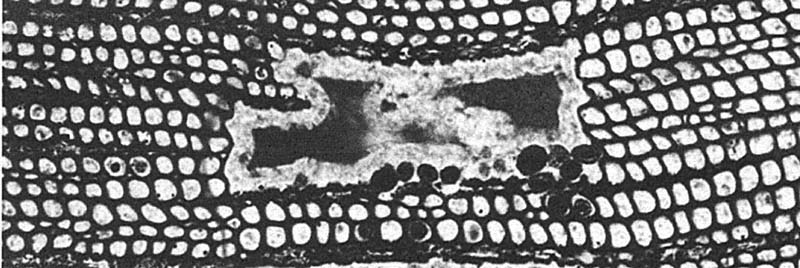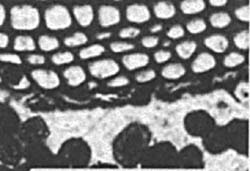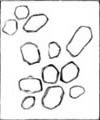Palaeozoic mites that never
existed
Like
unicorns and mermaids in fairy tales, oribatid mites enjoy a virtual
existence
in palaeobotany, where they are supposed to have gnawed through
palaeozoic
wood all
over the world. A considerable number of scientific publications has
been
devoted to them but their reputation seems to have declined lately,
except for
two recent papers promoted by R.
Rößler and
Z. Feng
[1,2].
A serious problem with the subject has been formulated in [2]: "No
evidence
of body fossils was found in the specimen, although tunnel geometry and
coprolite dimension suggest that oribatid mites were the most probable
culprit." The absence of body fossils in the specimen in [2] might be
considered incidental if there were not the fact that body fossils were
never
found in any palaeozoic wood allegedly inhabited by oribatid mites.
Furthermore,
not only
body fossils are absent but moults, too, although it is known from
palaeozoic
arachnids that fossil moults are found more often than fossil bodies.
There
is a simple solution to the serious problem in [1,2] and every other
publication on the subject: There were no mites. Only one picture from
[2] is sufficient to provide evidence for this
supposition:
 Fig.1:
Permian wood with local damage and peculiar arrangement of cell-size
dark clots generally thought to be oribatid mite coprolites.
Fig.1:
Permian wood with local damage and peculiar arrangement of cell-size
dark clots generally thought to be oribatid mite coprolites.
Detail of Fig.1C in [2]. Width of the picture 1.2mm.
Very similar: Fig.2D in [2].
Close
inspection of Fig.1 reveals details of the arrangement of the dark
clots
which are incompatible with the interpretation as coprolites. At the
bottom of the angular cavity in the wood there are orderly
rows of 3 or 4 cell-size
clots fitting
to the rows of cells which most probably had been there when the clots
had not yet been there.
Intact cells whose cross-sections are not yet
completely filled with one clot each are seen beneath.
Earlier stages of clot growth are seen elsewhere, as in two
neighbouring cells left of the cavity. All these
details justify a conclusion already formulated in a comment
on [1]:
To every alleged oribatid
mite coprolite there had been a cell which produced it.
There is lots of additional evidence for this in silicified wood
samples and even in the very pictures published by those who claim to
see coprolites. If inspected thoroughly, their pictures always reveal a
few clot sections with one or more straight contour lines meeting at an
angle which marks an edge of the clot: Fig.2.

Fig.2:
Cell-size clots, partially with distinct angles and straight contour
lines which are incompatible with the usual interpretation as
coprolites. Detail of Fig.1C in [2]. Width of the picture 0.3mm.
The
sections of the clots do not aways appear as polygons, for several
reasons: The clots may not have been moulded after the cell
cross-sections, the
cells may have been rounded inside, or the cut plane may be oriented
such that it mainly shows the rounded ends of the clots. The authors
fond of the mites do not notice the angular clots but see only the
rounded ones, calling them "ovoidal to sub-spheroidal coprolites" [2].
Similar misjudgement is common with related publications.
The lack
of thoroughness is particularly obvious in connection with Figs.3,4
where the authors ignore the straight sides
and distinct angles and try
to make believe that the
clots
are coprolites.

Fig.3: Damaged Permian wood with angular clots whose sizes and shapes
are compatible with those of nearby cells but nevertheless are regarded
as coprolites in [3]. Detail from Fig.3I in [3], bar = 0.2mm.

Fig.4
(left): Angular clots of various sizes and shapes fitting to the
various cells of nearby tissue of the Permian coniferous tree
Plyophyllioxylon,
interpreted in [4] as "spheroidal or ovoid shaped"
coprolites.
Drawing after detail from Fig.3C in [4].
The assumption that there
weren't any mites in those
Permian wood species is supported by
good reasons
which have been stated in Fossil
Wood News
20
and are repeated here:
(1) Angular clots are no coprolites.
(2) Clots with shapes and sizes fitting to nearby cells are no
coprolites.
(3) Clots inside cells are no coprolites.
(4) Clots arranged in chains and files fitting to the tissue are no
coprolites.
Hence the detailed discussions on mite borings and their implications
in [2-4] and other publications have been in vain.
The
alleged coprolites of the elusive oribatid mites may serve as a warning
against a kind of feedback which can elevate an initial folly to a
subject of worldwide vain research.
An incomplete compilation of illusory mite coprolite sightings is
given on this website under "Wood rot or coprolites".
H.-J.
Weiss 2015
[1] R.
Rößler, R. Kretzschmar, Z. Feng, R. Noll: Fraßgalerien von
Mikroarthropoden in Koniferenhölzern des frühen Perms von Crock,
Thüringen.
Veröff. Mus.
Naturkunde Chemnitz 37(2014), 55-66.
[2] Zhuo
Feng,
J.W. Schneider, C.C.
Labandeira, R. Kretzschmar, R.
Rößler: A specialized feeding habit of Early
Permian oribatid mites.
Palaeogeography,
Palaeoclimatology, Palaeoecology 417(2015), 121-124.
[3] Zhuo
Feng,
Jun Wang, Lu-Yun Liu: First report of
oribatid mite (arthropod) borings and
coprolites in Permian woods ...
Palaeogeography,
Palaeoclimatology, Palaeoecology 288(2010), 54-61.
[4] Zhuo
Feng,
Jun Wang, Lu-Yun Liu, R. Rößler A
novel coniferous tree trunk with septate pith ...
Ecological and evolutionary significance.
Int. J. Plant Sci.
173(2012), 835–848.
Annotation 2016:
At least,
R. Rößler
seems to give up trying to make believe that the absurd hypothesis of
oribatid mite coprolites is valid. Recently M.
Krings has shown that the alleged coprolites
in a paper by Barthel,
Krings,
Rößler (2010) are no such but tangles of fungus
hyphae as already proposed in Fossil
Wood News 4 in 2011.
|

|
 24 24 |

 24
24 Fig.1:
Permian wood with local damage and peculiar arrangement of cell-size
dark clots generally thought to be oribatid mite coprolites.
Fig.1:
Permian wood with local damage and peculiar arrangement of cell-size
dark clots generally thought to be oribatid mite coprolites. 



 24
24